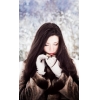|
 Winter coat
is the special garment in the wardrobe for both men and women and it is not the
alternative to status and luxury fur coats, cozy and comfortable sheepskin coats
and down-padded coats made from natural material. Whatever material is used for
coats, it is the garment worth mentioning in details and paying thorough
attention when choosing the style, texture and color. Winter coats are more purchased
by those who live in southern regions with mild and warm winter seasons. However,
coat is not the best article of clothing to save from winter frosts and it is more
used to look more elegant any time. Whatever purpose you chase, the coats vary
from designer to designer. Winter coat
is the special garment in the wardrobe for both men and women and it is not the
alternative to status and luxury fur coats, cozy and comfortable sheepskin coats
and down-padded coats made from natural material. Whatever material is used for
coats, it is the garment worth mentioning in details and paying thorough
attention when choosing the style, texture and color. Winter coats are more purchased
by those who live in southern regions with mild and warm winter seasons. However,
coat is not the best article of clothing to save from winter frosts and it is more
used to look more elegant any time. Whatever purpose you chase, the coats vary
from designer to designer.
When you go
shopping for winter coat, you’d better consider that coat is best to try over
the warm clothes and you’d better go and try it on wearing a sweater of large
knitting, as an alternative. Men go and try coats wearing costume suits and it
is best they can do. When the coat is your size, you put it on and take it away
easily; it has no wrinkles and folds. The qualified salesperson-consultant in
the stores are ready to consult on the way to choose the appropriate size when
the coat should be put on, buttoned and the hands should be put together in
front of you. If the coat is pulled on the back, the coat is not of your size,
when the folds are seen in the armpit it says of larger size than you need. The
perfect coat for you is when you feel comfortable while walking. The sleeves
should be to the middle of palms - no longer and no shorter length is adopted.
Texture of
fabric
Winter
coats are often made from cashmere, the subtle wool of goats. Such fabric is
durable which is the good advantage to others, but the drawback of the fabric
is plenty of pellets in the armpit, which is not good. Even the knitted scarf
over the cashmere coat can bring some pellets in some time.
Velour can
compete with cashmere in the subtle and smooth surface. Winter coats from velour
are very light though the fabric shines when it is worn for longer time.
The thick fabric
bouclé is perfect to warm in colder seasons though it consists of thousands of
knots and eyelets and such fabric is liable to such nuisance as strings which
make the expensive and elegant coat look miserable.
Tweed
and hopsack are considered the most practical fabric for winter coats. They never
fade in the sun though they need protection from moth as any other woolen
fabric.
The upper
part of the coat has no warming function and thus, it is provided with the
warmth-keeping lining. The natural fur has the best consuming feature for
coats. And it is easy to differ between the natural and artificial fur when a
hair is pulled and burnt. The natural fur burns well with the smell of burnt
hair while the hair of artificial fur melts longer.
The lining from
padding polyester or the sheet wadding is hidden with the satin or artificial
silk fabric. Lack of suture and threads tell of the quality tailoring. The coat
flaps should be of the equal length to avoid sagging.
Color and design
It is quite dirty in winter and most people prefer wearing darker colors
of coats.
The uppergarment of white-snow color is of the intimate nature when the
image is appropriate for thesolemn function though it is rather improper
for every day wear. Less soled colors include the golden, blue and
orange shades and these colors are the perfect antidepressant tools for
winter
period to endure the lack of sun and greenery. Light-skin women are
recommended
to get the winter coat of pink, red or raspberry-pink shade.
The fashion
designers offer the collections of winter coats for the coming season winter
2011. The coats come of laconic grey, dark-brown, beige and olive colors. On the
top of it, the popular trend is the leopard pattern. The design of coats is
close to military. The winter coats come as double-breasted with larger
buttons. The length of winter coats is varied, from the frivolous mini to
conservative maxi. The trendy silhouettes are the close-fitted and trapeze
style to be in favor this season.
|